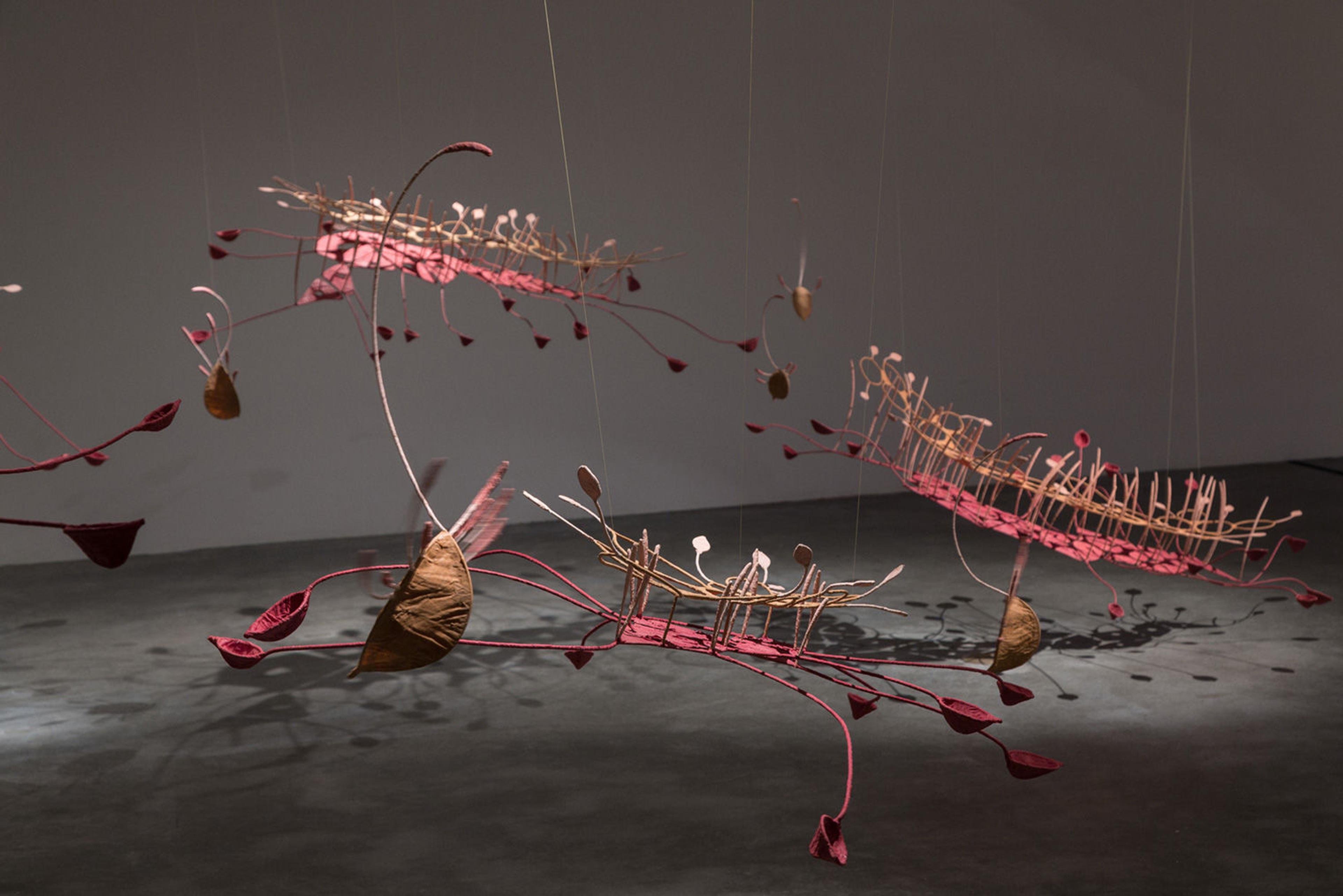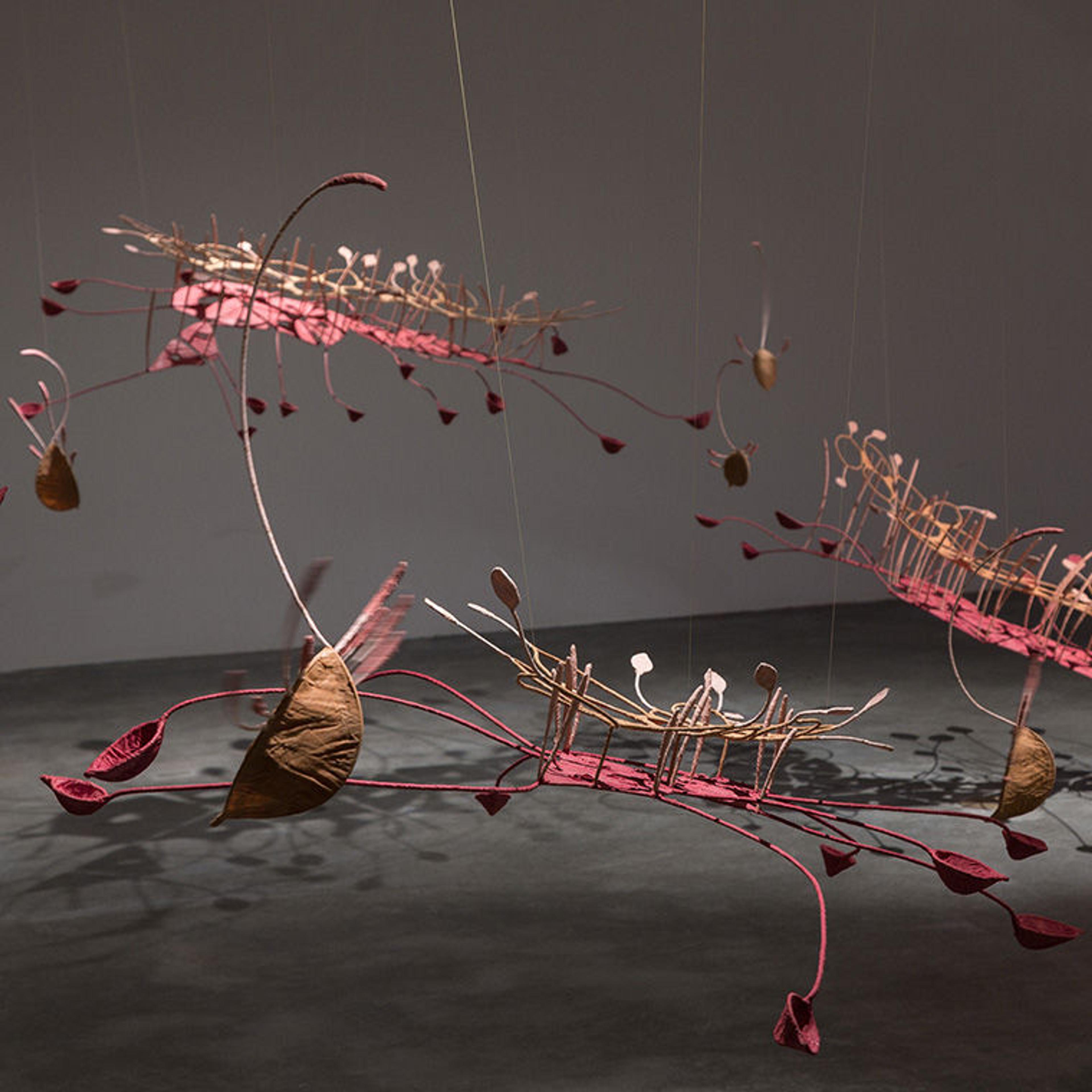
Ranjani Shettar (Indian, born 1977). Seven ponds and a few raindrops (detail), 2017. Muslin, stainless steel, tamarind, natural dyes, 229 x 223 x 96 in. (581.7 x 566.4 x 243.8 cm). The Metropolitan Museum of Art, New York, Gift of Tia Collection, 2018 (2018.61a–p). © Ranjani Shettar. Courtesy Talwar Gallery, New York/New Delhi
The title of Ranjani Shettar's Seven ponds and a few raindrops (2017)—which joined The Met collection as a gift from the Tia Collection, and is on view through August 12—compels audiences to apprehend the sculpture's abstract elements as constitutive of a literal landscape of seven ponds. But we could also perceive its forms more figuratively—to be, perhaps, shape-shifting cellular organisms that lie beneath the surface of water, or even the constituent biology of organic forms.
In staging Seven ponds and few raindrops in a way that is instantly immersive, Shettar engenders a deeply affective phenomenological encounter for the viewer within her installation. Occupying almost the entirety of the gallery space, the installation elegantly swirls up, from near the ground toward the ceiling, its elements caught mid-motion. In what has become somewhat of a signature gesture for the artist, the components are suspended in midair such that they seemingly defy gravity, and are dramatically lit to cast a series of spellbinding shadows. Together, this contributes to the sense of having stumbled upon a frozen moment of pure sublimity held within a hidden-away oasis.

Ranjani Shettar's Seven ponds and a few raindrops (detail)
The sixteen individual components of the artist's immersive installation were made over a period of nearly a year. As per her meticulous working method, Shettar handcrafted each element of the piece, first by welding and molding the stainless steel base, then by staining organic muslin cloth with three different dyes, and finally by binding the cloth to the steel armature with a paste made from tamarind trees. Such configurations of natural and manmade materials have always been a leitmotif of Shettar's work. As is evident with Seven ponds and a few raindrops, Shettar achieves a fine synthesis of unlikely materials, which is resonant with her worldview. As a result, the materials of her sculptures can be thought of as part of the artist's continuous search for a way to achieve a balance or some other sense of equilibrium.
Shettar derived her distinctive technique of fastening muslin to steel from a local crafts tradition employed by doll makers whom she observed in the small town of Kinhal, in the southwestern state of Karnataka, India. While traditional doll makers use rawhide and leather, Shettar's adapted technique, which instead makes use of woven fabric, speaks to her personal code of ethics: "Rawhide did not go with my philosophy," the artist told Sculpture magazine.[1] And so she "started a journey to find an alternative material that did not involve violence."
This search led to a specific amalgam of materials first observed in her work Sun-sneezers blow light bubbles (2007–8), where the artist embraced this traditional technique. Over the ten ensuing years, Shettar has further developed and refined her interpretation of this craft. The sculptor's works throughout the past decade have employed muslin stained in only one color—a beige hue that occurs naturally from the tamarind paste. In Seven ponds and a few raindrops, Shettar introduces a series of three colors by using mud, a byproduct of petroleum, and the root of madder plants.

Ranjani Shettar (Indian, born 1977). Sun-sneezers blow light bubbles, 2007–8. Stainless steel, muslin cloth, tamarind kernel powder paste, and lacquer, dimensions variable. The Modern Art Museum of Fort Worth. © Ranjani Shettar. Image courtesy Talwar Gallery, New York/New Delhi

Ranjani Shettar's Seven ponds and a few raindrops (detail)
Such an evolving approach emphasizes that Shettar is concerned with her technique as more than a purely aesthetic end. Her artistic practice is both rooted in a particular context and is responsive to what surrounds it. Ultimately, it is administered equally by a subjective logic and ideology—one that incorporates observation, slowness, and social responsibility.
Shettar ascribes her attentiveness to textures and the inherent properties of materials to growing up in a home where handcrafted domestic objects were in constant, everyday use. To construct her works, the artist relies on memories of "past experiences, of being in a particular environment." She has said, "I allow time for an experience to grown on me in a tangible form."[2]
Indeed, Shettar's artisanal production imbues her work with the emphatic trace of a human hand. She engages her materials, coaxing them into such expressive conditions that they begin to seem denatured. Shettar has always maintained that the natural environment of rural India has been an abiding source of inspiration for her work. That environment is now under assault by multinational corporations that are involved in land grabbing, mining, and rapacious deforestation. Such threatening circumstances can inform another understanding of Shettar's work, in which we are asked to bear witness to such beauty and see it as a thing worth preserving.
Notes
[1] Chitra Balasubramaniam, "Playing with Creation: Ranjani Shettar," Sculpture (January 2012).
[2] "Touch," First City (January 2011).
Related Content
Ranjani Shettar: Seven ponds and a few raindrops is on view at The Met Fifth Avenue through August 12, 2018.
Huma Bhabha and Ranjani Shettar will be in conversation on Thursday, June 21, 2018, 6–7 pm.
Read more Collection Spotlights on the Collection Insights blog.
